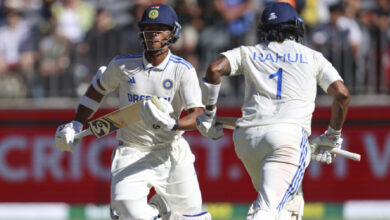Eliud Kipchoge’s next feat: The tactical Boston Marathon

Matthew Futterman
Eliud Kipchoge is marathon running’s ultimate speed demon.
Even at 38 years old, he still wins nearly every time he races. His win in Berlin last year made him 17 for 19. The technical term for that is “bananas.”
He breaks his own world record over and over. It’s now down to 2 hours, 1 minute and 9 seconds.
He is the only human (as far as we know) to have run 26.2 miles in less than two hours, finishing a course in Vienna designed to optimize speed, with a pace team taking turns blocking the wind, in 1:59.40. That is an average pace of 4 minutes and 34.5 seconds for the 26.2 mile race.
On Monday, though, Kipchoge will confront a new challenge as he tries to win the Boston Marathon, a horic, hilly beast of a course where tactics usually trump speed. Boston could not be more different from the mostly flat marathons in Berlin and London, races that can resemble time trials.
An undated photo provided On Running shows Hellen Obiri on a long training run in Colorado. Obiri moved from Kenya to Boulder, Colo., to chase a running accomplishment she has yet to achieve: dominance in the marathon. (On Running via The New York Times)
Even he doesn’t know how his body will react, or if he will be able to continue the magic. But Boston is the oldest continuously run marathon, a race that Kipchoge said was on his bucket l for a while. He especially wanted to run on the 10th anniversary of the Boston Marathon bombing, “to spread the word of positivity, the human family,” he said, even if he is feeling unsettled ahead of the competition in a way he is not used to feeling.
“I don’t know what will happen at 10, 15, 25 kilometers,” he said during an interview last month from Kenya, where he was training. “It’s a huge experience and a different experience than many other marathons. That’s what makes me nervous.”
Mere mortals might manage those nerves studying the unique undulations of the course, which heads downhill for most of the first 16 miles, has four lung-busting uphills over the next 5 miles, then heads mostly down and flat to the finish. They might also ask for advice from other elite runners and Boston champions. Kipchoge said he is not doing much of either.
Also, he has not trained any differently for this race. He is following his usual practice of building up to roughly 140 miles per week in Kenya’s highlands.
Eliud Kipchoge, a marathon runner, in Boston, April 14, 2023. The Boston Marathon, a tricky, hilly beast of a course, has humbled legends in the past. Can this master of speed tackle Heartbreak Hill? (Ian MacLellan/The New York Times)
“I concentrate on becoming fit,” he said. “The moment I’m fit enough, then actually, I can go through everything.”
Kipchoge’s Zen-like bravado — his slogan has become “no human is limited” — has turned him into a folk hero across the globe. In Kansas City, Missouri, an elementary school class with many African refugee children who worship Kipchoge, was assigned to write an essay with the prompt “no human is limited.” Their teacher, Megan Jefferson, is running the marathon on Monday, too.
But this race has toppled greats before. Abebe Bikila of Ethiopia, a two-time Olympic gold medal who was the barefoot Kipchoge of his era, finished fifth in Boston in 1963, the only time he completed an international marathon without winning it.
Bill Rodgers, the local hero known as Boston Billy, won his hometown marathon four times, but he dropped out at 20 miles in his first attempt and finished 14th in his second. Rodgers also won four New York City Marathons, conquering another hilly, rolling course that Kipchoge has yet to try.
FILE — Runners await the start of the Boston Marathon in the small town of Hopkinton, Mass. on Oct. 11, 2021. From the rural suburbs to the bedlam of Fenway Park, the annual event is as special as dance running gets. (Hilary Swift/The New York Times)
“New York and Boston are the great challenges,” Rodgers said during an interview this month. “If he has any weakness, someone will be there because it is a deadly field.”
So how might Kipchoge win?
“Hard to give advice to the G.O.A.T.,” Meb Keflezighi, the 2014 champion, wrote at in a text message. But then he relented, suggesting that Kipchoge wait until Heartbreak Hill around the 20-mile mark to make his move. “I would assume others will try to make the move early so he can be uncomfortable on the hill,” Keflezighi said.
Bob Larsen, Keflezighi’s longtime coach, said Kipchoge should pay close attention to the wind when deciding whether to try to break Geoffrey Mutai’s course record of 2:03.02. The Boston course runs due east from Hopkinton to downtown Boston. Winds from the east can wreak havoc.
“If it’s hot or a strong headwind, I’d advise just going for the win,” Larsen said. “If it’s cool with a tail wind or cross wind he can run at a record pace. Ease a little bit through the hills so at 21 miles his legs will still be strong enough to take advantage of the downhills on the way to the finish.”
Eliud Kipchoge, a marathon runner, in Boston, April 14, 2023. The Boston Marathon, a tricky, hilly beast of a course, has humbled legends in the past. Can this master of speed tackle Heartbreak Hill? (Ian MacLellan/The New York Times)
Nobody knows Boston better than Dave McGillivray, the race director who has completed the course 50 times on race day and another 42 in training. McGillivray said anyone hoping to win needs to stay with the lead pack through the halfway mark in Wellesley, then slowly begin to separate.
“Come here with lots of patience,” McGillivray said. “Come here knowing the shape of your competition on that day, and come here knowing exactly what is up ahead in front of you. It is anything but the typical flat and fast race that most pros have run.”
Kipchoge has succeeded in races that aren’t all about speed, especially two hot, tactical marathons at the Olympics in 2016 in Brazil and in 2021 in Japan.
“I think Boston is like the Olympics,” he said. “It’s a new environment to me. Well selected people. It’s like a championship race.”
As Keflezighi put it at the end of his text message, “Can’t wait to see what happens.”
This article originally appeared in The New York Times.







